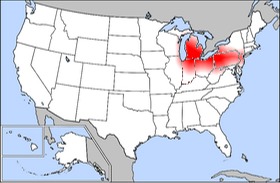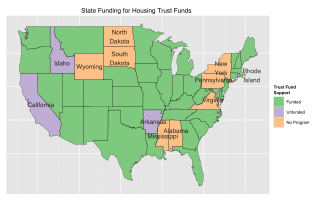Related Research Articles

Gentrification is the process of changing the character of a neighborhood through the influx of more affluent residents and businesses. It is a common and controversial topic in urban politics and planning. Gentrification often increases the economic value of a neighborhood, but the resulting demographic displacement may itself become a major social issue. Gentrification often sees a shift in a neighborhood's racial or ethnic composition and average household income as housing and businesses become more expensive and resources that had not been previously accessible are extended and improved.

Allentown is a city in and the county seat of Lehigh County, Pennsylvania, United States. It is the third-largest city in Pennsylvania with a population of 125,845 as of the 2020 census and the largest city in the Lehigh Valley metropolitan area, which had a population of 861,899 and was the 68th-most populous metropolitan area in the United States as of 2020.
The Low-Income Housing Tax Credit is a dollar-for-dollar tax credit in the United States for affordable housing investments. It was created under the Tax Reform Act of 1986 (TRA86) and gives incentives for the utilization of private equity in the development of affordable housing aimed at low-income Americans, with affordability restrictions on the properties expiring 15-30 years later. LIHTC accounts for the majority of all newly created affordable rental housing in the United States today. The maximum rent that can be charged for designated affordable units is based on Area Median Income (AMI), and over 50% of residents in LIHTC properties are considered Extremely Low-Income. The credits are also commonly called Section 42 credits in reference to the applicable section of the Internal Revenue Code. The tax credits are more attractive than tax deductions as the credits provide a dollar-for-dollar reduction in a taxpayer's federal income tax, whereas a tax deduction only provides a reduction in taxable income. The "passive loss rules" and similar tax changes made by TRA86 greatly reduced the value of tax credits and deductions to individual taxpayers. Less than 10% of current credit expenditures are claimed by individual investors.

A college town or university town is a community that is dominated by its university population. The university may be large, or there may be several smaller institutions such as liberal arts colleges clustered, or the residential population may be small, but college towns in all cases are so dubbed because the presence of the educational institution(s) pervades economic and social life. Many local residents may be employed by the university—which may be the largest employer in the community—many businesses cater primarily to the university, and the student population may outnumber the local population.
Inclusionary zoning (IZ), also known as inclusionary housing, refers to municipal and county planning ordinances that require a given percentage of units in a new housing development be affordable by people with low to moderate incomes. The term inclusionary zoning indicates that these ordinances seek to counter exclusionary zoning practices, which exclude low-cost housing from a municipality through the zoning code. Non-profit affordable housing developers build 100% of their units as affordable, but need significant taxpayer subsidies for this model to work. Inclusionary zoning allows municipalities to have new affordable housing constructed without taxpayer subsidies. In order to encourage for-profit developers to build projects that include affordable units, cities often allow developers to build more total units than their zoning laws currently allow so that there will be enough profit generating market-rate units to offset the losses from the below market-rate units and still allow the project to be financially feasible. Inclusionary zoning can be mandatory or voluntary, though the great majority of units have been built as a result of mandatory programmes. There are variations among the set-aside requirements, affordability levels, and length of time the unit is deed-restricted as affordable housing.

Tax increment financing (TIF) is a public financing method that is used as a subsidy for redevelopment, infrastructure, and other community-improvement projects in many countries, including the United States. The original intent of a TIF program is to stimulate private investment in a blighted area that has been designated to be in need of economic revitalization. Similar or related value capture strategies are used around the world.
Flipping is a term used to describe purchasing a revenue-generating asset and quickly reselling it for profit.
A tax incentive is an aspect of a government's taxation policy designed to incentivize or encourage a particular economic activity by reducing tax payments.
CityNorth is a planned urban mixed-use development in the Northeast Valley of Phoenix, Arizona, US; featuring retail, restaurant, residential, hotel, office, cultural, civic and entertainment uses in a pedestrian-friendly environment. At completion, CityNorth will comprise more than 5,500,000 square feet of development on 144 acres. Envisioned by Thomas J. Klutznick as the urban core of the Northeast Valley of Phoenix and the commercial core for the master-planned community of Desert Ridge, CityNorth is sited near the intersection of two major freeways—Loop 101 and State Route 51, making it accessible from throughout the Phoenix metropolitan area. The development will open in phases starting with Phase One, High Street, which opened in November 2008.
Renewal Communities (RCs) and Empowerment Zones (EZs) are distressed urban and rural communities in the United States where qualifying businesses are eligible for billions of dollars in tax incentives. They were created in the Community Renewal Tax Relief Act of 2000, which was eventually passed as part of the Consolidated Appropriations Act, 2001.

Keystone Opportunity Zones (KOZ) are specific commercial or industrial areas with greatly reduced or no tax burden for property owners, residents and businesses throughout the Commonwealth of Pennsylvania. Pennsylvania is also known as the Keystone State, hence the name. The first KOZ's were established in 1999 by the Pennsylvania State Legislature and signed into law by Tom Ridge, who was then the Governor of Pennsylvania. As of 2008, KOZ's are still being supported by continuing acts of the state legislature and the former governor Ed Rendell. The zones are located throughout Pennsylvania in 12 separate regions: Northwest, Southwest, North Central, Southern Alleghenies, Northern Tier, Central, South Central, Lackawanna/Luzerne, Schuylkill/Carbon, Lehigh Valley, Southeast, and Philadelphia. Many of the sites are located in pre-existing airports and industrial parks.

Patrick M. Browne is an American accountant, lawyer, and politician. A Republican, he served as a member of the Pennsylvania House of Representatives (1995–2005) and Pennsylvania Senate (2005–2022). On January 12, 2023, Democratic Governor-elect Josh Shapiro nominated Browne to serve as Secretary of Revenue.

The Allentown Parking Authority is responsible for both off and on-street parking within the City of Allentown, Pennsylvania.

A carbon fee and dividend or climate income is a system to reduce greenhouse gas emissions and address climate change. The system imposes a carbon tax on the sale of fossil fuels, and then distributes the revenue of this tax over the entire population as a monthly income or regular payment.

Housing trust funds are established sources of funding for affordable housing construction and other related purposes created by governments in the United States (U.S.). Housing Trust Funds (HTF) began as a way of funding affordable housing in the late 1970s. Since then, elected government officials from all levels of government in the U.S. have established housing trust funds to support the construction, acquisition, and preservation of affordable housing and related services to meet the housing needs of low-income households. Ideally, HTFs are funded through dedicated revenues like real estate transfer taxes or document recording fees to ensure a steady stream of funding rather than being dependent on regular budget processes. As of 2016, 400 state, local and county trust funds existed across the U.S.

The Americus Hotel is an historic hotel, which is located in Allentown, Pennsylvania. It was built between 1926 and 1927, and is a thirteen-story yellow brick building.

The Community Renewal Tax Relief Act of 2000 is a bill that was introduced into the United States House of Representatives during the 106th United States Congress. The Act was eventually passed as part of the Consolidated Appropriations Act, 2001.

The gentrification of San Francisco has been an ongoing source of tension between renters and working people who live in the city as well as real estate interests. A result of this conflict has been an emerging antagonism between longtime working-class residents of the city and the influx of new tech workers. A major increase of gentrification in San Francisco has been attributed to the Dot-Com Boom in the 1990s, creating a strong demand for skilled tech workers from local startups and close by Silicon Valley businesses leading to rising standards of living. As a result, a large influx of new workers in the internet and technology sector began to contribute to the gentrification of historically poor immigrant neighborhoods such as the Mission District. During this time San Francisco began a transformation eventually culminating in it becoming the most expensive city to live in the United States.
Municipal disinvestment is a term in the United States which describes an urban planning process in which a city or town or other municipal entity decides to abandon or neglect an area. It can happen when a municipality is in a period of economic prosperity and sees that its poorest and most blighted communities are both the cheapest targets for revitalization as well as the areas with the greatest potential for improvement. It is when a city is facing urban decay and chooses to allocate fewer resources to the poorest communities or communities with less political power, and disenfranchised neighborhoods are slated for demolition, relocation, and eventual replacement. Disinvestment in urban and suburban communities tends to fall strongly along racial and class lines and may perpetuate the cycle of poverty exerted upon the space, since more affluent individuals with social mobility can more easily leave disenfranchised areas.
References
- ↑ "What is a Neighborhood Improvement Zone?". WHYY. Retrieved 2020-12-07.
- ↑ "History". www.allentownpa.gov. Retrieved 2020-12-07.
- ↑ "Reinvention in the Rust Belt". www.cnn.com. Retrieved 2020-12-07.
- ↑ "2009 Act 50". The official website for the Pennsylvania General Assembly. Retrieved 2020-12-07.
- ↑ "2011 Act 26". The official website for the Pennsylvania General Assembly. Retrieved 2020-12-07.
- ↑ "2012 Act 87". The official website for the Pennsylvania General Assembly. Retrieved 2020-12-07.
- ↑ "Neighborhood Improvement Zone". www.allentownpa.gov. Retrieved 2020-12-07.
- ↑ Tierney, John (2014-09-15). "Breathing Life Into Allentown: Pennsylvania Comes to the Rescue". The Atlantic. Retrieved 2020-12-07.
- ↑ "Tax Compendium". Pennsylvania Department of Revenue. Retrieved 2020-12-07.
- ↑ Call, Scott Kraus and Matt Assad, Of The Morning. "Allentown arena zone collects $48.2 million in state taxes". mcall.com. Retrieved 2020-12-07.
{{cite web}}: CS1 maint: multiple names: authors list (link) - ↑ "Deep Tax Incentives Fuel $1 Billion in New Development in Allentown, PA: Four Perspectives". www.philadelphiafed.org. Retrieved 2020-12-07.
- ↑ "How business elites sold the "urban renewal" lie to the Rust Belt". Salon. 2019-12-03. Retrieved 2020-12-07.
- ↑ "Your View: Allentown's NIZ is working for developers, but not for nearby neighborhoods - The Morning Call". webcache.googleusercontent.com. Retrieved 2020-12-07.
- ↑ Hurdle, Jon (2014-03-04). "Tax Program Aims to Reverse Decades-Long Decline in Allentown (Published 2014)". The New York Times. ISSN 0362-4331 . Retrieved 2020-12-07.
- ↑ "Allentown's Neighborhood Improvement Zone". Georgetown Public Policy Review. Retrieved 2020-12-07.
- ↑ Althouse, Stephen. "Local group discusses downtown Allentown gentrification concerns". WFMZ.com. Retrieved 2020-12-07.
- ↑ "Completed Projects". ANIZDA. Retrieved 2020-12-07.